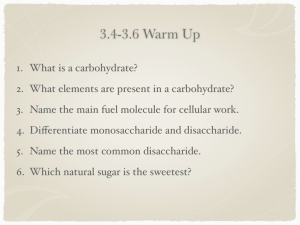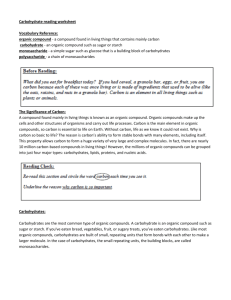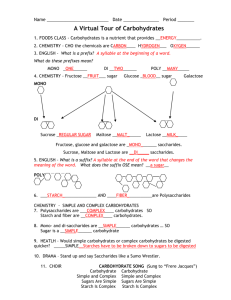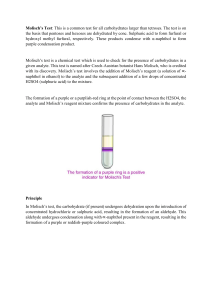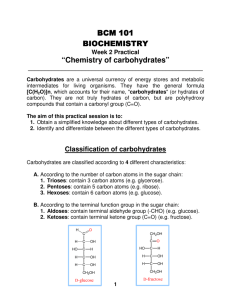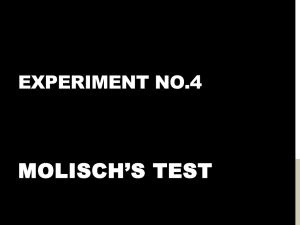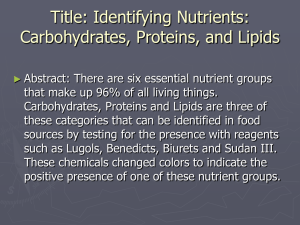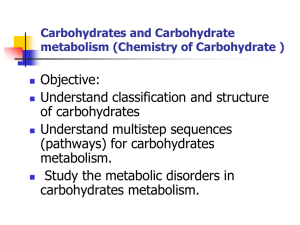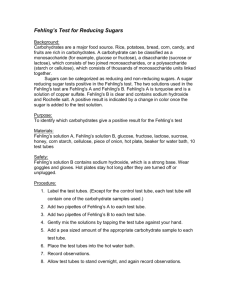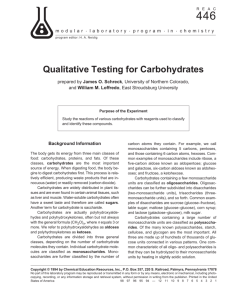Carbohydrates
advertisement
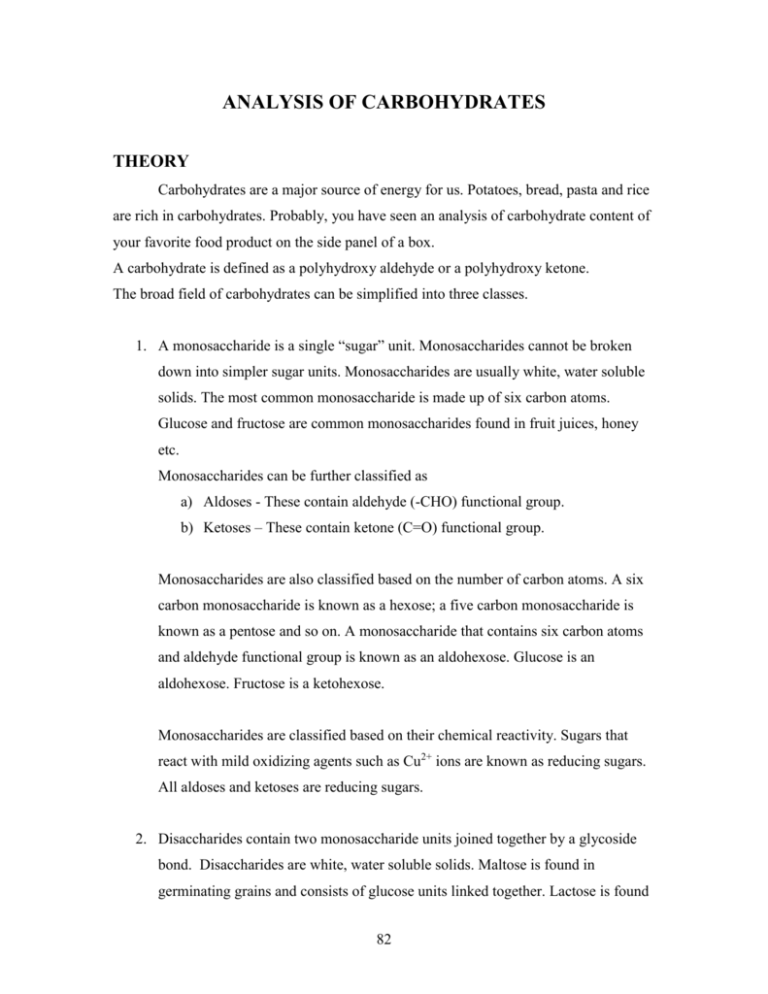
ANALYSIS OF CARBOHYDRATES THEORY Carbohydrates are a major source of energy for us. Potatoes, bread, pasta and rice are rich in carbohydrates. Probably, you have seen an analysis of carbohydrate content of your favorite food product on the side panel of a box. A carbohydrate is defined as a polyhydroxy aldehyde or a polyhydroxy ketone. The broad field of carbohydrates can be simplified into three classes. 1. A monosaccharide is a single “sugar” unit. Monosaccharides cannot be broken down into simpler sugar units. Monosaccharides are usually white, water soluble solids. The most common monosaccharide is made up of six carbon atoms. Glucose and fructose are common monosaccharides found in fruit juices, honey etc. Monosaccharides can be further classified as a) Aldoses - These contain aldehyde (-CHO) functional group. b) Ketoses – These contain ketone (C=O) functional group. Monosaccharides are also classified based on the number of carbon atoms. A six carbon monosaccharide is known as a hexose; a five carbon monosaccharide is known as a pentose and so on. A monosaccharide that contains six carbon atoms and aldehyde functional group is known as an aldohexose. Glucose is an aldohexose. Fructose is a ketohexose. Monosaccharides are classified based on their chemical reactivity. Sugars that react with mild oxidizing agents such as Cu2+ ions are known as reducing sugars. All aldoses and ketoses are reducing sugars. 2. Disaccharides contain two monosaccharide units joined together by a glycoside bond. Disaccharides are white, water soluble solids. Maltose is found in germinating grains and consists of glucose units linked together. Lactose is found 82 in milk and consists of glucose and galactose units linked together. Sucrose is found in sugar cane and consists of glucose and fructose. Monosaccharide + Monosaccharide → Disaccharide + H2O 3. Polysaccharides contain many units of monosaccharides linked together. Starch is found in grains, glycogen is found in muscles and cellulose is found in plants, cotton and paper. They are all made up of glucose molecules linked in different arrangements. MOLISCH TEST - A GENERAL TEST FOR CARBOHYDRATES In this test, Molisch reagent is mixed with a dilute solution of carbohydrate. Concentrated sulfuric acid is introduced carefully, and a purple color develops at the interface if a carbohydrate is present. Carbohydrates undergo dehydration reactions (loss of water) in the presence of concentrated sulfuric acid. Pentoses and hexoses form five member oxygen containing rings on dehydration. The five member ring, known as furfural, further reacts with Molisch reagent to form colored compounds. This test is known as the Molisch test and is used to detect carbohydrates in several substances. FEHLING’S OR BENEDICT’S TEST FOR REDUCING SUGARS All monosaccharides and many disaccharides reduce weak oxidizing agents like Cu2+ ion. These carbohydrates are called reducing sugars. Fehling’s solution (contains Cu2+) changes color from blue to red/brown in the presence of reducing sugars. IODINE TEST FOR STARCH AND OTHER POLYSACCHARIDES Starch is a polysaccharide that can be easily identified by the iodine test. The many glucose units in starch trap the I2 molecules and form a dark blue-black complex. Mono and disaccharides are too small and are unable to form a complex with I2. Cellulose, a polysaccharide does not form colored complexes with I2. 83 BARFOED’S TEST TO DISTINGUISH BETWEEN MONO- AND DISACCHARIDES Barfoed’s reagent is copper acetate in acetic acid and not as reactive as Benedict’s reagent. A positive reaction may only be a light red precipitate. Monosaccharides produce the red precipitate in 2 to 3 minutes; disaccharides produce the precipitate in 10 minutes. SELIWANOFF’S TEST FOR KETOHEXOSES Seliwanoff’s test is used to distinguish aldohexoses from ketohexoses. A ketohexose like fructose will form a deep red color with Seliwanoff’s reagent while an aldohexose will show a light pink color and takes a longer time to develop the color. BIAL’S TEST FOR PENTOSES This test is used to distinguish pentoses and hexoses. Pentoses give a positive test with Bial’s reagent. In the presence of concentrated HCl, pentoses form a five member ring, known as furfural. The formation of furfural is indicated by a blue-green color in the presence of Bial’s reagent (contains resorcinol and ferric ions). A positive test is the formation of a bluish-green color within 5 minutes without the formation of a precipitate. OBJECTIVES 1. Become familiar with common carbohydrates 2. Learn significant differences in the chemical properties of carbohydrates 3. Identify the carbohydrates present in common food products PROCEDURE GENERAL INSTRUCTIONS Fill a 400 mL beaker about half with water and heat it over a Bunsen Burner or a hot plate. You’ll need the water bath for several of the tests, so you may need to add water as the water boils away. Perform the various tests with each of the given carbohydrates. 84 A. TESTS FOR CARBOHYDRATES 1. Place 1 mL of the carbohydrate solution in a clean test tube. Add 2 drops of Molisch reagent and mix well. Incline the test tube and slowly add 0.5 mL of concentrated sulfuric acid in drops along the sides of the test tube. Record any changes. Is the given substance a carbohydrate or not? 2. Place 1 mL of the carbohydrate solution in a test tube. Add 1 mL of Fehling’s solution and mix well. Place all the test tubes into the water bath for five minutes. Record any changes. Is the sample a reducing or non reducing sugar? 3. Place 1 mL of the carbohydrate solution and add 2 drops of iodine reagent and stir well. Wait for 10 minutes. Record any changes. Is the sample a polysaccharide? 4. Use the same procedure as Fehling’s solution, but substitute Seliwanoff reagent. Record any changes. Is the sample a ketohexose? 5. Place 1 mL of carbohydrate solution and 1 mL of Bial’s reagent and mix well. Heat the test tube in the flame until solution boils. Record any changes. Is the sample a pentose sugar? B. IDENTIFYING YOUR UNKNOWN CARBOHYDRATE Using the results you obtained in the tests above, identify your unknown as glucose, fructose, lactose, sucrose, arabinose, starch or none of these. TESTING FOODS FOR CARBOHYDRATES Obtain a food product. Perform the above tests and record your observations. Describe what kinds of carbohydrates are in the food product. For example, Molisch test - purple color Fehling’s test - a rapid formation of a deep red color Iodine test – turned dark blue Conclusion - The food sample contains a reducing sugar (Fehling’s test and Molisch test) and starch (Iodine). 85 OBSERVATIONS Indicate + or – for each test with carbohydrate sample. Sample Molisch Fehling Iodine Glucose Fructose Lactose Sucrose Arabinose Starch Unknown Food product 86 Seliwanoff Bial Conclusion on the unknown food product __________________________ _________________________________________________________________ _________________________________________________________________ 87

